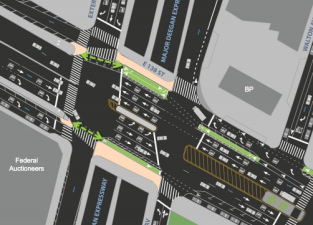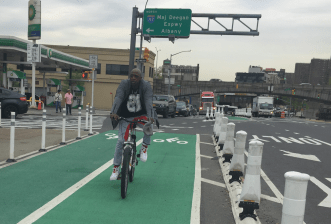New in 2016: Safe, Convenient Bike Connections Linking East Harlem and the Bronx

Yesterday the Chrystie Street protected bike lane had its official unveiling, marking a huge improvement to the bike connection between Manhattan and downtown Brooklyn. All the way at the other end of the East Side of Manhattan, DOT made another big improvement this year to interborough bridge access for cyclists.
It’s a two-block bidirectional bike lane connecting the protected bike lanes on First and Second Avenues to the Willis Avenue Bridge and Triborough Bridge [PDF].
Before this project, if you were biking from the Bronx over the Willis Avenue Bridge, you had no good options once you got to First Avenue and 125th Street. Biking on wide, highly-trafficked 125th Street was a legal connection to Second Avenue and points west, but it was extremely intimidating.
A less stressful option was to go down First Avenue to East 124th Street, but that was illegal and entailed biking on the sidewalk or against traffic.
DOT’s project fixed this weak spot in the bike network by making the informal route a safe, well-designed — and legal — option. With new two-way protected bike lanes on First Avenue between East 125th Street to East 124th Street, and on 124th Street between First Avenue and Second Avenue, there are now safe, direct connections from the on-street bike network to the paths on the Willis Avenue and Triborough bridges.

At the intersection of 124th Street and Second Avenue, where the bike lane converges with an on-ramp for the Triborough Bridge, DOT made some adjustments to its original plan, which called for cyclists to use crosswalks to get from the bridge to Second Avenue, make a convoluted jog to get from 124th Street to Second Avenue, and also had no clear route for southbound cyclists to get onto 124th Street.

As implemented, the project gives cyclists making these three movements more intuitive options. The bike lane by the Triborough entrance traverses the motor vehicle lane on 124th Street, then connects to the protected lane on Second Avenue.

This short bi-directional segment is also useful for southbound cyclists on Second Avenue looking to get over to 124th Street:
One shortcoming of the project is the absence of protection on First Avenue as it approaches the bridge, putting cyclists dangerously close to high-speed traffic.
Also missing is directional signage. The new configuration works well but may not be very intuitive. Yesterday I saw one cyclist headed toward the Willis Avenue Bridge via the treacherous, construction-plagued block of East 125th Street.



